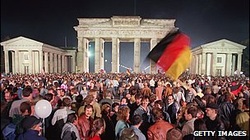Title.

At a stroke on 3 October 1990, German reunification transformed Europe's geopolitical landscape, less than a year after the fall of the Berlin Wall.
For many people, there seemed to be much to celebrate. Communism in Europe was dead. Eastern Europe was free from the Soviet yoke. The Cold War was declared over.
But there was also apprehension in some places that the nation which had unleashed the Nazi tyranny on most of Europe in World War II was once again united, with by far the largest population in Europe.
The old order, dominated by the victor nations from the war, was crumbling. Britain's then Prime Minister, Margaret Thatcher, voiced the fear that an "over-mighty" Germany would again destabilise Europe.
But over time Germany allayed such anxieties. The assurance repeated often by Helmut Kohl, the chancellor of German unity, was that German reunification and European integration should advance together as two sides of the same coin.
That persuasive formula became the new orthodoxy for Europe as a whole. So from the start Germany was at the very heart of the European "project" of ever-deeper integration, involving the countries of Western and Eastern Europe alike.
For many people, there seemed to be much to celebrate. Communism in Europe was dead. Eastern Europe was free from the Soviet yoke. The Cold War was declared over.
But there was also apprehension in some places that the nation which had unleashed the Nazi tyranny on most of Europe in World War II was once again united, with by far the largest population in Europe.
The old order, dominated by the victor nations from the war, was crumbling. Britain's then Prime Minister, Margaret Thatcher, voiced the fear that an "over-mighty" Germany would again destabilise Europe.
But over time Germany allayed such anxieties. The assurance repeated often by Helmut Kohl, the chancellor of German unity, was that German reunification and European integration should advance together as two sides of the same coin.
That persuasive formula became the new orthodoxy for Europe as a whole. So from the start Germany was at the very heart of the European "project" of ever-deeper integration, involving the countries of Western and Eastern Europe alike.
